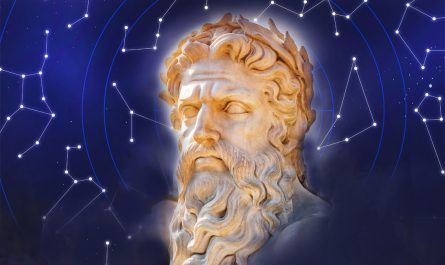Last Updated on October 2, 2025 by Avia
What did the Asclepius’ snake say to the Uroboros? “What’s got you tied up in a knot?” Ha ha. Dad jokes aside, Greek snakes found on the staff of Asclepius, the twin snakes of the Caduceus, and the tail-eating Uroboros have some powerful meaning attached to them. Now, I realize snakes (of Greek origin or otherwise) aren’t high on everybody’s guest list at a symbolic soiree. I mean, they’re potentially intimidating, slithery, and they make folks freak out (in theory – I happen to love snakes). Anyhoo – it’s their power, prowess, & presence that – my friends – makes snakes profoundly powerful symbols in ancient Greece. With this in mind, I thought wax on about the symbolic meaning of three Greek snakes as found in ancient symbols like the Uroboros, Asclepius, and Caduceus. If that sounds intriguing to you, I’d be delighted if you kept reading.
Table of Contents
- Introduction to Ancient Greek Snakes and Their Meanings
- Symbolic Meaning of Ancient Greek Snakes
- Greek Snakes Featured in Mythology
- Greek Snake Meaning in Medicine and Healing
- Snakes in the Tarot
- Greek Snakes in Alchemy
- Snakes in Ancient Greek Spirituality
- Frequently Asked Questions About Greek Snake Meaning
- Closing Thoughts About Greek Snake Symbolism
Introduction to Ancient Greek Snakes and Their Meanings
Unraveling the mysteries of ancient Greek symbolism is like embarking on a captivating journey through time. Among the many intriguing symbols that have survived throughout history, snakes hold a prominent place in Greek culture and mythology. These slithering creatures are not just ordinary reptiles; snakes carry profound symbolic meaning that has captivated minds for centuries.
Symbolic Meaning of Ancient Greek Snakes
Greek mythology is rich with symbolism, and the snake is a powerful, frequently appearing symbol. In ancient Greece, snakes held a significant role in both spiritual and cultural contexts. These creatures were associated with various symbolic meanings that continue to captivate our imagination today.
In Greek mythology, snakes were often seen as symbols of transformation and renewal. They shed their skin, representing the cycle of life and death. This metamorphosis made them potent symbols for healing and regeneration.
Snakes were also connected to wisdom and knowledge in ancient Greece. The snake’s ability to slither through tight spaces was considered a metaphor for gaining hidden insights or easily navigating difficult situations.
Meaning of the Snake in the Staff of Asclepius

Asclepius was the Greek god of purification, healing and medicine, and his sacred staff featured a single snake coiled around it. This image has become synonymous with medical professions today.
The snake represents renewal, transformation, and rejuvenation – all qualities that are essential for healing. It sheds its skin and emerges renewed, just as patients hope to emerge from illness or injury healed.
In addition to physical healing, the serpent also embodies wisdom and knowledge. Snakes were believed to possess secret knowledge about herbs and remedies that could cure ailments.
The presence of a serpent on the staff emphasizes physical health and spiritual well-being. It serves as a reminder that true healing involves addressing both body and soul.
The snake in the Staff of Asclepius symbolizes resilience, wisdom, transformation, and holistic healing – all fundamental aspects of medicine that aim to restore balance in individuals’ lives.
Meaning of the Double Snakes of the Caduceus Symbol

The double snakes of the Caduceus symbol hold deep meaning in Greek mythology and symbolism. The intertwined serpents represent a balance between opposing forces, making it a powerful emblem of harmony and equilibrium.
In ancient Greece, the Caduceus was associated with Hermes, the messenger of the gods. Hermes used this staff as he traveled between realms to bring peace and resolution to conflicts. The two snakes winding around each other signify duality – male and female, light and dark, life and death – encapsulating the concept of balance inherent in all things.
These serpents also embody healing energy and transformation. Snakes shed their skin as they grow, symbolizing renewal and rejuvenation. Similarly, the intertwining snakes of the Caduceus demonstrate an ongoing cycle of change within oneself.
Furthermore, some interpretations suggest that these dual serpents reflect Kundalini energy. This divine energy represents spiritual awakening and enlightenment.
The double snakes on the Caduceus serve as a reminder that harmony can be found even amidst opposing forces. They encourage us to embrace polarity in our lives while seeking unity within ourselves.
Overall, the significance of these intertwined serpents is profound – representing balance, duality, and transformation. They remind us to find harmony amidst opposing forces, balance our energies, and seek personal growth.
Symbolic Meaning of the Uroboros

The Uroboros (also spelled Ouroboros) is a Greek symbol of great significance and represents the eternal cycle of life and death. It is depicted as a serpent or dragon swallowing its own tail, forming a circular shape. This ancient symbol holds deep mystical and philosophical meaning.
One interpretation of the Uroboros is that it signifies the endless cycle of creation and destruction. Just as the snake consumes itself, only to be born again from its old self, so too does life continuously regenerate itself in an unending loop.
In alchemy, the Uroboros represent transformation and rebirth. The process of transmutation requires breaking down old structures to create something new and refined. This symbolism mirrors our personal journeys of growth and evolution.
Furthermore, the Uroboros embodies wholeness and unity. By containing both ends within itself, it symbolizes integration and balance between opposing forces – light and dark, masculine and feminine, yin-yang – creating harmony within ourselves and in our surroundings.
The circular nature of the Uroboros also points toward infinity; there is no beginning or end. It reminds us that everything in existence is interconnected – past, present, and future all coexist simultaneously.
As we delve deeper into understanding this powerful symbol’s meaning in Greek culture, we discover how it serves as a reminder to embrace change with grace while acknowledging that endings are merely opportunities for new beginnings.
Greek Snakes Featured in Mythology
Greek mythology is rich with stories that feature snakes as prominent characters or symbols. One such myth involves the goddess Hera, who famously transformed a woman named Callisto into a bear out of jealousy. To ensure Callisto’s fate was sealed, Hera placed her under the watchful eye of the hundred-eyed giant Argus. However, Zeus intervened and sent his son Hermes to rescue Callisto by putting Argus to sleep with his magical staff, which just happened to be adorned with intertwining snakes. Sound familiar? Yup, that’s the Asclepius connection.
In another tale, Apollo himself encountered a python serpent while on his way to establish the oracle at Delphi. In a fierce battle, he managed to slay the mighty snake and claim its lair as his own sanctuary. From then on, Apollo became associated with healing and prophecy.
The story of Medusa is perhaps one of the most well-known instances where snakes play a significant role in Greek mythology. Once a beautiful maiden, Athena cursed Medusa for betraying her sacred temple. Her hair turned into venomous serpents while her gaze could turn anyone who looked upon her into stone.
These examples show how snakes were seen as creatures of power and represented transformation and danger in Greek mythology. They often served as warnings or reminders of divine intervention and consequences for human actions.
Greek Snake Meaning in Medicine and Healing

We’ve already mentioned how snakes are connected to healing and medicine in Greek history, but because it’s such an important touchstone, I think it bears elaboration.
In ancient times, snakes were believed to possess divine powers and were revered for their ability to shed their skin, symbolizing renewal and rejuvenation.
In Greek mythology, the god Asclepius was often depicted with a snake wrapped around his staff. This image became known as the Staff of Asclepius, which is still used as a symbol of medicine today. The snake represents wisdom, knowledge, and healing, while the staff represents balance and stability.
The serpent’s association with medicine extends beyond just its representation on the Staff of Asclepius. Snakes were also believed to have medicinal properties themselves. Their venom was thought to contain potent healing qualities, capable of curing various ailments when used in controlled doses.
Furthermore, snakes were seen as intermediaries between humans and the gods due to their connection with both earth (through slithering) and sky (through shedding). They were believed to bring messages from deities about health issues or remedies.
In addition to these beliefs surrounding snakes in ancient Greece, they also played a role in spiritual healing practices such as dream interpretation or divination rituals involving serpents.
Snakes in the Tarot

In tarot decks, you may come across cards featuring snakes or serpents, such as the Magician or the Lovers card. These reptiles symbolize wisdom, intuition, and spiritual awakening. They remind us to shed our old skin and embrace personal growth.
When a snake appears in a tarot reading, it often signifies profound changes on the horizon. It urges us to tap into our inner strength and embrace transformational opportunities that present themselves. Like the snake shedding its skin, we must also let go of what no longer serves us in order to make room for new beginnings.
The presence of a snake in a tarot spread can also represent hidden knowledge or secrets coming to light. It encourages us to trust our instincts and delve deeper into situations that require discernment.
However, it’s important to note that interpretation may vary depending on other elements within the spread and individual intuition during a reading. Each person’s connection with these symbols is unique.
Greek Snakes in Alchemy
Alchemy, the ancient practice of transmuting base metals into gold and seeking spiritual enlightenment, also incorporates symbolism associated with Greek snakes. Snakes often appear as vital symbols representing transformation and rebirth in alchemical texts and illustrations.
The snake sheds its skin, a powerful metaphor for shedding old patterns and transforming into something new. This concept aligns perfectly with the alchemical pursuit of inner change and personal growth. Additionally, the serpent’s ability to move effortlessly between realms symbolizes the alchemist’s quest for transcending earthly limitations.
In alchemical symbolism and imagery, snakes frequently intertwine or form circles known as Ouroboros – a snake biting its own tail. This symbolizes eternity and cyclical nature; it represents an eternal cycle of creation and destruction inherent in all things.
Moreover, snakes are connected to Mercury (Hermes), who is highly significant in alchemy due to his role as a messenger between worlds. The caduceus – an emblem featuring two entwined serpents on a staff topped with wings – is associated with Hermes/Mercury. It signifies balance between opposing forces, harmonizing duality within oneself.
Through their presence in alchemy, Greek snakes bring forth potent symbolism that encourages seekers of spiritual wisdom to embrace transformational journeys toward self-realization. These serpentine symbols breathe life into esoteric teachings while reminding us of our innate capacity for evolution and renewal.
Snakes in Ancient Greek Spirituality

Ancient Greek spirituality was deeply intertwined with nature, and snakes played a significant role in their belief system. In Greek mythology, snakes were often seen as sacred creatures associated with healing and transformation.
The Greeks believed that snakes possessed divine wisdom and had the ability to bridge the distance between the physical world and the spiritual realm. Snakes were considered guardians of sacred spaces such as temples and oracles.
In addition to their protective qualities, snakes were also seen as symbols of rebirth and renewal. The shedding of their skin represented the cycle of life, death, and rebirth – a concept that resonated strongly with the Greeks’ understanding of existence.
Priests would often seek guidance from snake oracles, who would interpret the movements and behaviors of these mystical creatures to gain insight into future events or important decisions.
For ancient Greeks, encountering a snake was seen as a sign from the gods themselves. It was believed that if a snake crossed your path or appeared in your dreams, it carried an important message or warning from higher powers.
While some cultures may view snakes as sinister or evil creatures, ancient Greeks held them in high regard for their symbolism of wisdom, protection, transformation, and connection to the divine. Snakes served as powerful reminders for individuals to embrace change and seek spiritual enlightenment throughout their lives.
Frequently Asked Questions About Greek Snake Meaning
The Caduceus, featuring two snakes intertwined around a winged staff, has various interpretations. In ancient Greek mythology, it was associated with Hermes, the messenger of gods. The intertwining snakes represent duality and balance. Some believe that the Caduceus symbolizes healing and protection.
The Staff of Asclepius features a single snake wrapped around a rod or staff. It is often used as a symbol of healing and medicine. Asclepius was an ancient Greek god associated with health and medicine, making this symbol widely recognized in medical communities worldwide.
Uroboros depicts a serpent or dragon devouring its own tail, forming a circle. This ancient symbol represents eternal cycles, infinity, and unity – concepts deeply rooted in Greek philosophy and spirituality.
Snakes played significant roles across various aspects of Ancient Greek culture beyond their symbolic meanings in mythology and medicine. They were also revered as sacred creatures representing wisdom, rebirth, transformation, fertility, and protection against evil forces.
Closing Thoughts About Greek Snake Symbolism
In this exploration of Greek snake symbolism, we have delved into the rich meanings and associations surrounding three significant symbols: the Caduceus, the Staff of Asclepius, and the Uroboros.
While their symbolic meanings may vary depending on context or interpretation, the common thread that runs through them is how they embody transcendence from limitations and grounded wisdom derived from nature.
So next time you encounter one of these fascinating creatures depicted in art or literature, take a moment to appreciate their significance. The legacy left behind by Greek snake symbolism serves as a reminder that there is always more than meets the eye when exploring ancient cultures’ beliefs about life’s mysteries! As always, thanks for reading!
Mighty brightly,

© Copyrighted. All Rights Reserved.
Avia’s Amazon Picks for You
Know More! Amazon Selections About Gods, Goddesses, and Myths
Sharpen Your Symbol Savvy With These Amazon Selections
Want more? Me too! That’s why I’ve also got this for you on Whats-Your-Sign:













